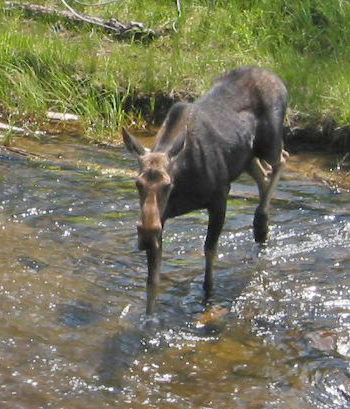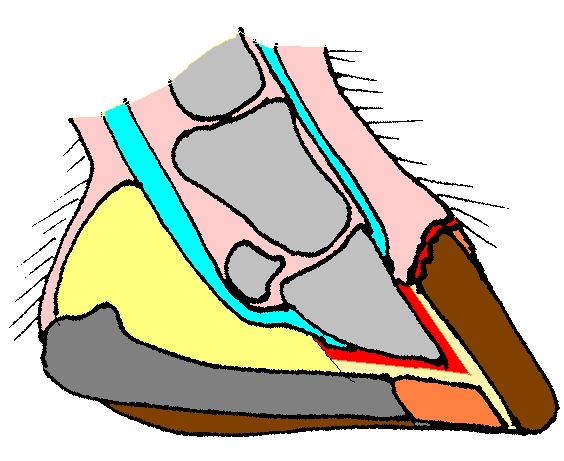|
Litopterna
Litopterna (from "smooth heel") is an extinction, extinct order of South American native ungulates that lived from the Paleocene to the Pleistocene-Holocene around 62.5 million to 12,000 years ago (or possibly as late as 3,500 years ago), and were also present in Antarctica during the Eocene. They represent the second most diverse group of South American ungulates after Notoungulata. It is divided into nine families, with Proterotheriidae and Macraucheniidae being the most diverse and last surviving families. Diversity The body forms of many litopterns, notably in the limb and skull structure, are broadly similar to those of living ungulates, unlike other South American native ungulate groups, which are often strongly divergent from living ungulates. Paleocene and Eocene litopterns generally had small body masses, with ''Protolipterna'' (Protolipternidae) estimated to have had a body mass of , though the Eocene Sparnotheriodontidae, sparnotheriodontids were considerably large ... [...More Info...] [...Related Items...] OR: [Wikipedia] [Google] [Baidu] |
Protolipterna
''Protolipterna'' is an extinct genus of mammal, belonging to the order Litopterna. It lived during the Late Paleocene and the Early Eocene, in what is now South America. Description It was a small-sized animal, not exceeding 35 centimeters in length ; it weighed approximately one kilogram. It had a compact body and elongated and slender legs. Its general appearance was comparable to that of a modern chevrotain. Its dentition possessed low-crowned brachyodont and bunodont molars, but it also had long upper fang-shaped canines, not unlike today's chevrotains. Its legs, elongated and slender, suggest a digitigrade gait, unlike its contemporaries, such as ''Colbertia'', which were plantigrades. Classification ''Prtolitopterna ellipsodotoides'' was first described by Cifelli in 1983, based on fragmentary mandible preserving teeth, found in the Itaboraí Formation of Brazil, in terrains dated from the end of the Paleocene or the Early Eocene. Several other fossils were later found, ... [...More Info...] [...Related Items...] OR: [Wikipedia] [Google] [Baidu] |
Theosodon
''Theosodon'' is an extinct genus of litoptern mammal from the Early to Middle Miocene of South America. Description ''Theosodon'' was long-legged with a long neck resembling modern llamas or guanacos. It was large for a litoptern, reaching up to in length and weighing up to . It had a long neck and tapir-like, three-toed feet, and like other litopterns and modern horses, tapirs and rhinos, it bore its weight on its middle toes. Extraordinarily, rather than having nostrils at the front of its head, ''Theosodon'' had its nostrils on the top of its snout, halfway between the forehead and the tip of the snout, and its nostrils pointed upwards rather than forwards, possibly as an adaptation for browsing on prickly vegetation. History and species ''Theosodon'' has been known since the 19th century, and by 1910 seven species had been described within the genus, all from the early Miocene Santa Cruz Formation in Argentina. The name ''Theosodon'' means "god tooth". The first f ... [...More Info...] [...Related Items...] OR: [Wikipedia] [Google] [Baidu] |
Macrauchenia
''Macrauchenia'' ("long llama", based on the now-invalid llama genus, ''Auchenia'', from Greek "big neck") is an extinct genus of large ungulate native to South America from the Pliocene or Middle Pleistocene to the end of the Late Pleistocene. It is a member of the extinct order Litopterna, a group of South American native ungulates distinct from the two orders which contain all living ungulates which had been present in South America since the early Cenozoic, over 60 million years ago, prior to the arrival of living ungulates in South America around 2.5 million years ago as part of the Great American Interchange. The bodyform of ''Macrauchenia'' has been described as similar to a camel, being one of the largest-known litopterns, with an estimated body mass of around 1 tonne. The genus gives its name to its family, Macraucheniidae, which like ''Macrauchenia'' typically had long necks and three-toed feet, as well as a retracted nasal region, which in ''Macrauchenia'' manifests as t ... [...More Info...] [...Related Items...] OR: [Wikipedia] [Google] [Baidu] |
Notoungulata
Notoungulata is an extinct order of ungulates that inhabited South America from the early Paleocene to the end of the Pleistocene, living from approximately 61 million to 11,000 years ago. Notoungulates were morphologically diverse, with forms resembling animals as disparate as rabbits and rhinoceroses. Notoungulata are the largest group of South American native ungulates, with over 150 genera in 14 families having been described, divided into two major subgroupings, Typotheria and Toxodontia. Notoungulates first diversified during the Eocene. Their diversity declined from the late Neogene onwards, with only the large Toxodontidae, toxodontids persisting until the end of the Pleistocene (with ''Mixotoxodon'' expanding into Central America and southern North America), perishing as part of the Late Pleistocene extinctions, Late Pleistocene megafauna extinctions along with most other large mammals across the Americas. Collagen sequence analysis suggests that notoungulates are closely ... [...More Info...] [...Related Items...] OR: [Wikipedia] [Google] [Baidu] |
Scalabrinitherium
''Scalabrinitherium'' is an extinct genus of mammals of the family Macraucheniidae. Fossils of this animal were found among the fossils of prehistoric xenarthrans in the Ituzaingó Formation of Argentina.''Scalabrinitherium'' at .org Description This animal was rather similar to a with a slightly heavy build; the was long and low, the front teeth were slightly spatulate, and the nasal aperture set far back. It is possible tha ...[...More Info...] [...Related Items...] OR: [Wikipedia] [Google] [Baidu] |
Saiga Antelope
The saiga antelope (, ''Saiga tatarica''), or saiga, is a species of antelope which during antiquity inhabited a vast area of the Eurasian steppe, spanning the foothills of the Carpathian Mountains in the northwest and Caucasus in the southwest into Mongolia in the northeast and Dzungaria in the southeast. During the Pleistocene, it ranged across the mammoth steppe from the British Isles to Beringia. Today, the dominant subspecies (''S. t. tatarica'') only occurs in Kalmykia and Astrakhan Oblast of Russia and in the Ural, Ustyurt and Betpak-Dala regions of Kazakhstan. A portion of the Ustyurt population migrates south to Uzbekistan and occasionally to Turkmenistan in winter. It is regionally extinct in Romania, Ukraine, Moldova, China and southwestern Mongolia. The Mongolian subspecies (''S. t. mongolica'') occurs only in western Mongolia. Taxonomy and phylogeny The scientific name ''Capra tatarica'' was coined by Carl Linnaeus in 1766 in the 12th edition of ''Systema Natu ... [...More Info...] [...Related Items...] OR: [Wikipedia] [Google] [Baidu] |
Moose
The moose (: 'moose'; used in North America) or elk (: 'elk' or 'elks'; used in Eurasia) (''Alces alces'') is the world's tallest, largest and heaviest extant species of deer and the only species in the genus ''Alces''. It is also the tallest, and the second-largest, land animal in North America, falling short only to the American bison in body mass. Most adult male moose have broad, palmate ("open-hand shaped") antlers; other members of the deer family have pointed antlers with a dendritic ("twig-like") configuration. Moose inhabit the circumpolar boreal forests or temperate broadleaf and mixed forests of the Northern Hemisphere, thriving in cooler, temperate areas as well as subarctic climates. Hunting shaped the relationship between moose and humans, both in Eurasia and North America. Prior to the colonial era (around 1600–1700 CE), moose were one of many valuable sources of sustenance for certain tribal groups and First Nations. Hunting and habitat loss hav ... [...More Info...] [...Related Items...] OR: [Wikipedia] [Google] [Baidu] |
Thoatherium
''Thoatherium'' (meaning "active swift-beast") is an extinct genus of litoptern mammals from the Early Miocene of Argentina. Fossils of the genus have been found in the Santa Cruz Formation in Argentina.''Thoatherium'' at .org Description With a length of , the -like ''Thoatherium'' was a small representative of the order . Judging from its long legs, it was a fast runner. ''Thoatherium'' had remarkably reduced toes; ...[...More Info...] [...Related Items...] OR: [Wikipedia] [Google] [Baidu] |
Hoof
The hoof (: hooves) is the tip of a toe of an ungulate mammal, which is covered and strengthened with a thick and horny keratin covering. Artiodactyls are even-toed ungulates, species whose feet have an even number of digits; the ruminants with two digits are the most numerous, e.g. giraffe, deer, bison, cattle, goats, gazelles, pigs, and sheep. The feet of perissodactyl mammals have an odd number of toes, e.g. the horse, the rhinoceros, and the tapir. Although hooves are limb structures primarily found in placental mammals, hadrosaurs such as '' Edmontosaurus'' possessed hoofed forelimbs. The marsupial '' Chaeropus'' also had hooves. Description The hoof surrounds the distal end of the second phalanx, the distal phalanx, and the navicular bone. The hoof consists of the hoof wall, the bars of the hoof, the sole and frog and soft tissue shock absorption structures. The weight of the animal is normally borne by both the sole and the edge of the hoof wall. Hooves perform man ... [...More Info...] [...Related Items...] OR: [Wikipedia] [Google] [Baidu] |
Bunodont
The molars or molar teeth are large, flat teeth at the back of the mouth. They are more developed in mammals. They are used primarily to grind food during chewing. The name ''molar'' derives from Latin, ''molaris dens'', meaning "millstone tooth", from ''mola'', millstone and ''dens'', tooth. Molars show a great deal of diversity in size and shape across the mammal groups. The third molar of humans is sometimes vestigial. Human anatomy In humans, the molar teeth have either four or five cusps. Adult humans have 12 molars, in four groups of three at the back of the mouth. The third, rearmost molar in each group is called a wisdom tooth. It is the last tooth to appear, breaking through the front of the gum at about the age of 20, although this varies among individuals and populations, and in many cases the tooth is missing. The human mouth contains upper (maxillary) and lower (mandibular) molars. They are: maxillary first molar, maxillary second molar, maxillary third molar, man ... [...More Info...] [...Related Items...] OR: [Wikipedia] [Google] [Baidu] |
Adianthus
''Adianthus'' is an extinct genus of litoptern that lived during the Early Miocene to the Middle Miocene in what is now Argentina and Chile. Description This animal is only known from fragmentary remains, mainly from its teeth, and was probably similar to its relative '' Adiantoides''. It was a small animal with generalist teeth, but it had some unusual characteristics. The crown of its teeth was higher than in ''Adiantoides'', and the lower premolars were more molariform. The second lower incisor and the lower canine had three lingually directed ridges, forming two closed basins. The first three premolars had two ridges, while the fourth premolar was completely molariform. Classification ''Adianthus bucatus'' was first described in 1891 by Florentino Ameghino, based on a single tooth of enigmatic shape, perhaps coming from the so-called "''Notohippus'' beds". Subsequently, Ameghino described a mandible with teeth as a new species, ''Adianthus patagonicus''; however, those rema ... [...More Info...] [...Related Items...] OR: [Wikipedia] [Google] [Baidu] |
South American Native Ungulate
South American native ungulates, commonly abbreviated as SANUs, are extinct ungulate-like mammals that were indigenous to South America from the Paleocene (from at least 63 million years ago) until the end of the Late Pleistocene (~12,000 years ago). They represented a dominant element of South America's Cenozoic terrestrial mammal fauna prior to the arrival of living ungulate groups in South America during the Pliocene and Pleistocene as part of the Great American Interchange. They comprise five major groups conventionally ranked as Order (biology), orders—Astrapotheria, Litopterna, Notoungulata, Pyrotheria, and Xenungulata—as well as the primitive "condylarth" groups Didolodontidae and Kollpaniinae. It has been proposed that some or all of the members of this group form a clade, named Meridiungulata, though the relationships of South American ungulates remain largely unresolved. The two largest groups of South American ungulates, the notoungulates and the litopterns, were the ... [...More Info...] [...Related Items...] OR: [Wikipedia] [Google] [Baidu] |






